PONTIAC VIBE 2010 Owner's Manual
Manufacturer: PONTIAC, Model Year: 2010, Model line: VIBE, Model: PONTIAC VIBE 2010Pages: 318, PDF Size: 1.7 MB
Page 21 of 318
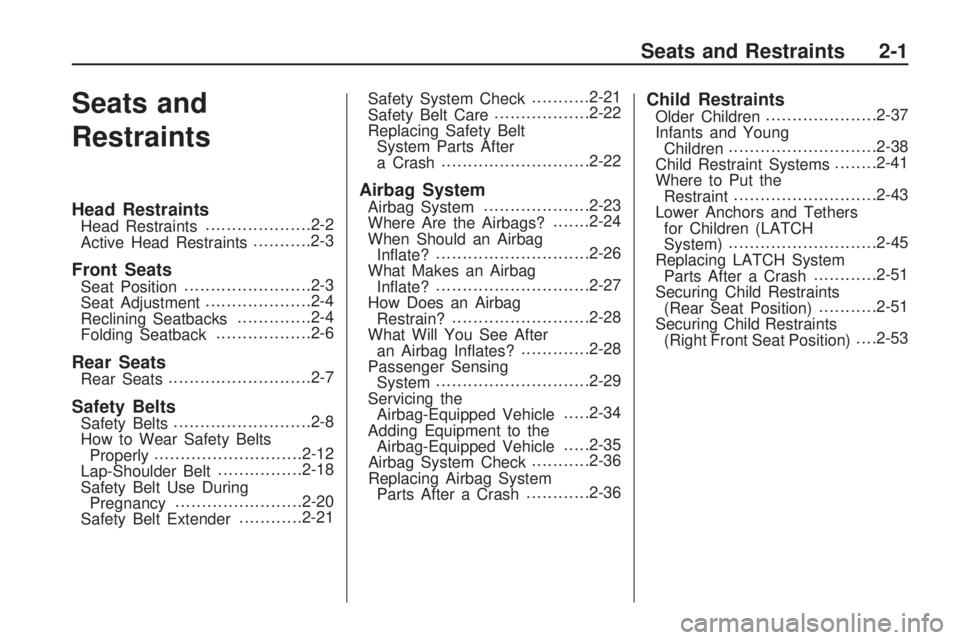
Seats and
Restraints
Head RestraintsHead Restraints...................
.2-2
Active Head Restraints ...........2-3
Front SeatsSeat Position.......................
.2-3
Seat Adjustment ...................
.2-4
Reclining Seatbacks .............
.2-4
Folding Seatback .................
.2-6
Rear SeatsRear Seats..........................
.2-7
Safety BeltsSafety Belts.........................
.2-8
How to Wear Safety Belts Properly ...........................
.2-12
Lap-Shoulder Belt ...............
.2-18
Safety Belt Use During Pregnancy .......................
.2-20
Safety Belt Extender ............2-21Safety System Check
...........2-21
Safety Belt Care .................
.2-22
Replacing Safety Belt System Parts After
a Crash ...........................
.2-22
Airbag SystemAirbag System...................
.2-23
Where Are the Airbags? .......2-24
When Should an Airbag Inflate? ............................
.2-26
What Makes an Airbag Inflate? ............................
.2-27
How Does an Airbag Restrain? .........................
.2-28
What Will You See After an Airbag Inflates? .............2-28
Passenger Sensing System ............................
.2-29
Servicing the Airbag-Equipped Vehicle .....2-34
Adding Equipment to the Airbag-Equipped Vehicle .....2-35
Airbag System Check ...........2-36
Replacing Airbag System Parts After a Crash ............2-36
Child RestraintsOlder Children....................
.2-37
Infants and Young Children ...........................
.2-38
Child Restraint Systems ........2-41
Where to Put the Restraint ..........................
.2-43
Lower Anchors and Tethers for Children (LATCH
System) ...........................
.2-45
Replacing LATCH System Parts After a Crash ............2-51
Securing Child Restraints (Rear Seat Position) ...........2-51
Securing Child Restraints (Right Front Seat Position) . . . .2-53
Seats and Restraints 2-1
Page 22 of 318

Head Restraints
The front seats have adjustable
head restraints. The rear seats have
adjustable headrests in all seating
positions.
{CAUTION
With head restraints that are not
installed and adjusted properly,
there is a greater chance that
occupants will suffer a neck/spinal
injury in a crash. Do not drive
until the head restraints for all
occupants are installed and
adjusted properly.Adjust the head restraint so that the
top of the restraint is at the same
height as the top of the occupant’s
head. This position reduces the
chance of a neck injury in a crash.
Pull the head restraint up to
raise it. To lower the head restraint,
press the button, located on the
top of the seatback, and push the
restraint down.
Push down on the head restraint
after the button is released to make
sure that it is locked in place.
2-2 Seats and Restraints
Page 23 of 318
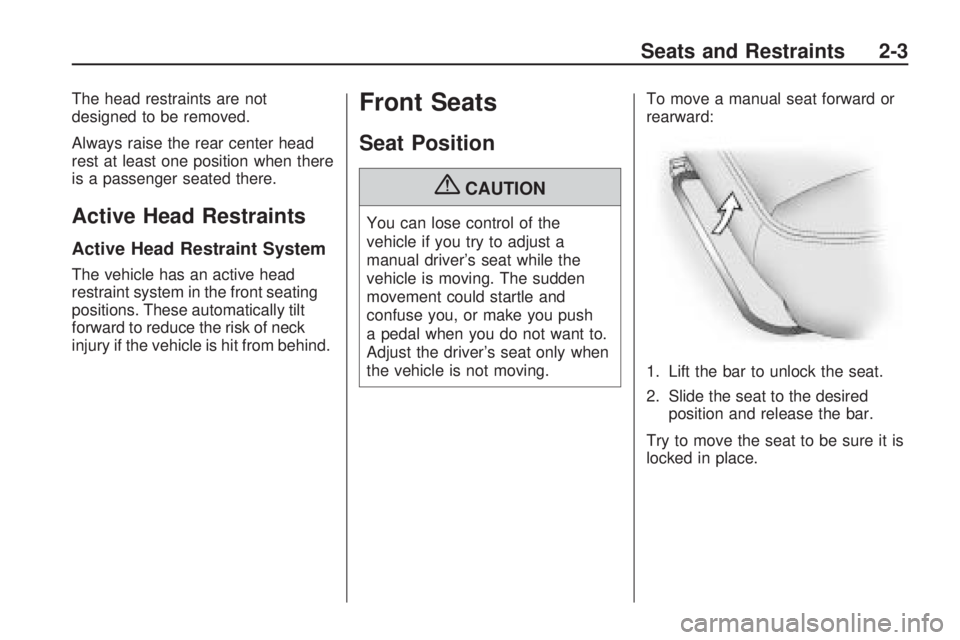
The head restraints are not
designed to be removed.
Always raise the rear center head
rest at least one position when there
is a passenger seated there.
Active Head Restraints
Active Head Restraint System
The vehicle has an active head
restraint system in the front seating
positions. These automatically tilt
forward to reduce the risk of neck
injury if the vehicle is hit from behind.
Front Seats
Seat Position
{CAUTION
You can lose control of the
vehicle if you try to adjust a
manual driver’s seat while the
vehicle is moving. The sudden
movement could startle and
confuse you, or make you push
a pedal when you do not want to.
Adjust the driver’s seat only when
the vehicle is not moving.To move a manual seat forward or
rearward:
1. Lift the bar to unlock the seat.
2. Slide the seat to the desired
position and release the bar.
Try to move the seat to be sure it is
locked in place.
Seats and Restraints 2-3
Page 24 of 318
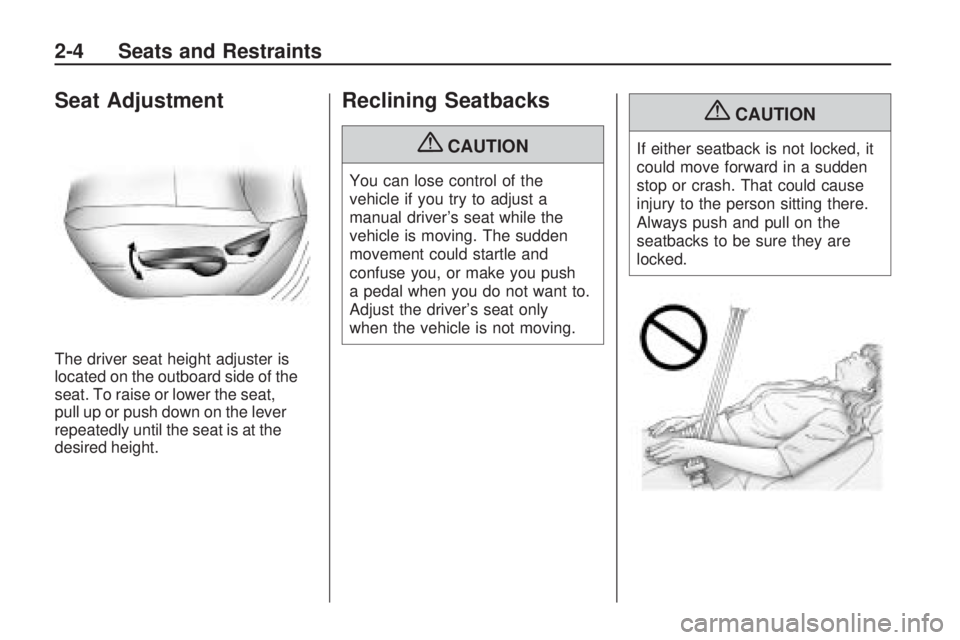
Seat Adjustment
The driver seat height adjuster is
located on the outboard side of the
seat. To raise or lower the seat,
pull up or push down on the lever
repeatedly until the seat is at the
desired height.
Reclining Seatbacks
{CAUTION
You can lose control of the
vehicle if you try to adjust a
manual driver’s seat while the
vehicle is moving. The sudden
movement could startle and
confuse you, or make you push
a pedal when you do not want to.
Adjust the driver’s seat only
when the vehicle is not moving.
{CAUTION
If either seatback is not locked, it
could move forward in a sudden
stop or crash. That could cause
injury to the person sitting there.
Always push and pull on the
seatbacks to be sure they are
locked.
2-4 Seats and Restraints
Page 25 of 318

{CAUTION
Sitting in a reclined position when
the vehicle is in motion can be
dangerous. Even when buckled
up, the safety belts cannot do
their job when reclined like this.
The shoulder belt cannot do its
job because it will not be against
your body. Instead, it will be in
front of you. In a crash, you could
go into it, receiving neck or other
injuries.(Continued)
CAUTION (Continued)
The lap belt cannot do its job
either. In a crash, the belt could
go up over your abdomen. The
belt forces would be there, not
at your pelvic bones. This could
cause serious internal injuries.
For proper protection when the
vehicle is in motion, have the
seatback upright. Then sit well
back in the seat and wear the
safety belt properly.
On vehicles with manual reclining
seatbacks the lever used to operate
them is located on the outboard
side of the seat. To recline the seatback:
1. Lift the recline lever.
2. Move the seatback to the desired
position, then release the lever to
lock the seatback in place.
3. Push and pull on the seatback to make sure it is locked.
To return the seatback to an upright
position:
1. Lift the lever fully, without applying pressure to the
seatback, and the seatback will
return to the upright position.
2. Push and pull on the seatback to make sure it is locked.
Seats and Restraints 2-5
Page 26 of 318
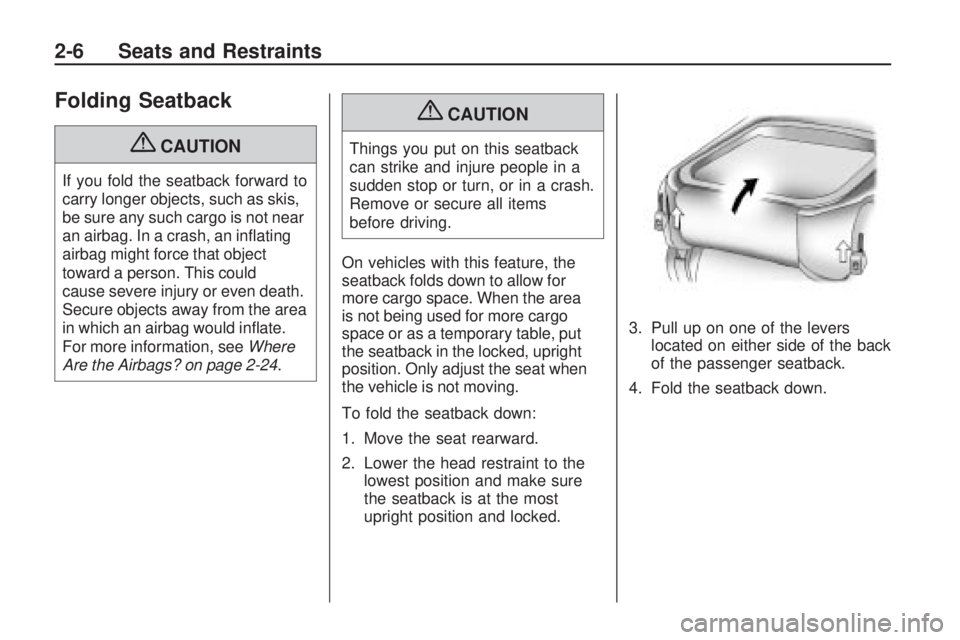
Folding Seatback
{CAUTION
If you fold the seatback forward to
carry longer objects, such as skis,
be sure any such cargo is not near
an airbag. In a crash, an inflating
airbag might force that object
toward a person. This could
cause severe injury or even death.
Secure objects away from the area
in which an airbag would inflate.
For more information, seeWhere
Are the Airbags? on page 2-24 .
{CAUTION
Things you put on this seatback
can strike and injure people in a
sudden stop or turn, or in a crash.
Remove or secure all items
before driving.
On vehicles with this feature, the
seatback folds down to allow for
more cargo space. When the area
is not being used for more cargo
space or as a temporary table, put
the seatback in the locked, upright
position. Only adjust the seat when
the vehicle is not moving.
To fold the seatback down:
1. Move the seat rearward.
2. Lower the head restraint to the lowest position and make sure
the seatback is at the most
upright position and locked. 3. Pull up on one of the levers
located on either side of the back
of the passenger seatback.
4. Fold the seatback down.
2-6 Seats and Restraints
Page 27 of 318

To raise the seatback:
1. Pull up on one of the leverslocated on either side of the back
of the passenger’s seatback.
2. Pull the seatback up and push it back to lock it into place. Make
sure the safety belt is not twisted
or caught in the seatback.
3. Push and pull the top of the seatback to be sure it is
locked into position.
4. Use the reclining front seatback lever to adjust the seatback to a
comfortable position.Rear Seats
You can fold either side of the
seatback down. The rear right side
seatback can also be used as a
temporary table while the vehicle
is stopped.
{CAUTION
A rear seatback folded forward,
or any other object contacting or
pressing the front seatback may
affect the proper functioning of
the passenger sensing system.
See Passenger Sensing System
on page 2-29.
To fold either seatback down:
1. Move the front seat forward and the seatback to the upright
position.
2. Move the headrests all the way down. 3. Pull up on the lock release knob,
located on the top outboard side
of the seatback.
Notice: Folding a rear seat with
the safety belts still fastened may
cause damage to the seat or the
safety belts. Always unbuckle the
safety belts and return them to
their normal stowed position
before folding a rear seat.
4. Fold the seatback down.
Seats and Restraints 2-7
Page 28 of 318
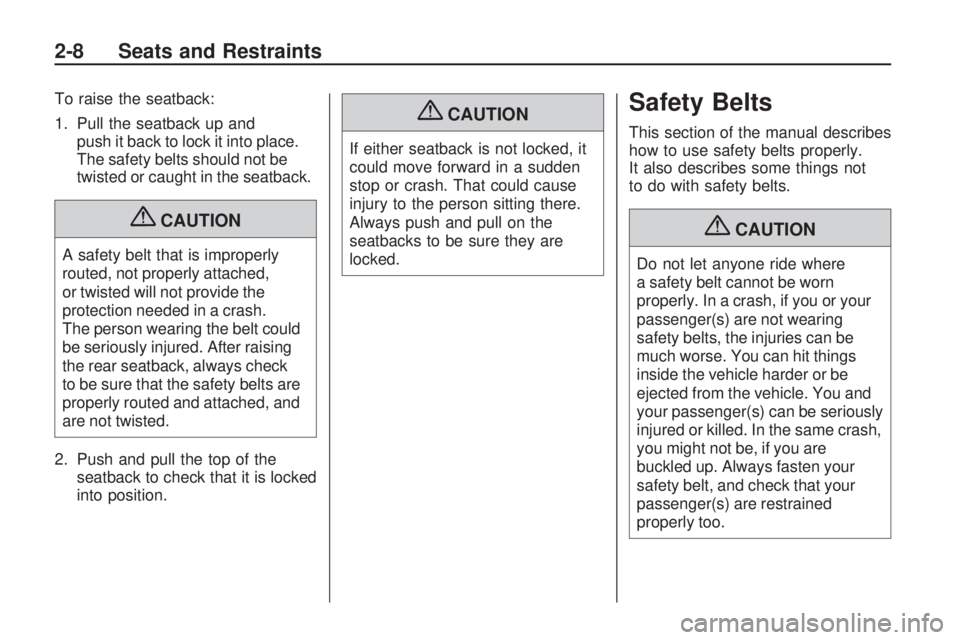
To raise the seatback:
1. Pull the seatback up andpush it back to lock it into place.
The safety belts should not be
twisted or caught in the seatback.
{CAUTION
A safety belt that is improperly
routed, not properly attached,
or twisted will not provide the
protection needed in a crash.
The person wearing the belt could
be seriously injured. After raising
the rear seatback, always check
to be sure that the safety belts are
properly routed and attached, and
are not twisted.
2. Push and pull the top of the seatback to check that it is locked
into position.
{CAUTION
If either seatback is not locked, it
could move forward in a sudden
stop or crash. That could cause
injury to the person sitting there.
Always push and pull on the
seatbacks to be sure they are
locked.
Safety Belts
This section of the manual describes
how to use safety belts properly.
It also describes some things not
to do with safety belts.
{CAUTION
Do not let anyone ride where
a safety belt cannot be worn
properly. In a crash, if you or your
passenger(s) are not wearing
safety belts, the injuries can be
much worse. You can hit things
inside the vehicle harder or be
ejected from the vehicle. You and
your passenger(s) can be seriously
injured or killed. In the same crash,
you might not be, if you are
buckled up. Always fasten your
safety belt, and check that your
passenger(s) are restrained
properly too.
2-8 Seats and Restraints
Page 29 of 318
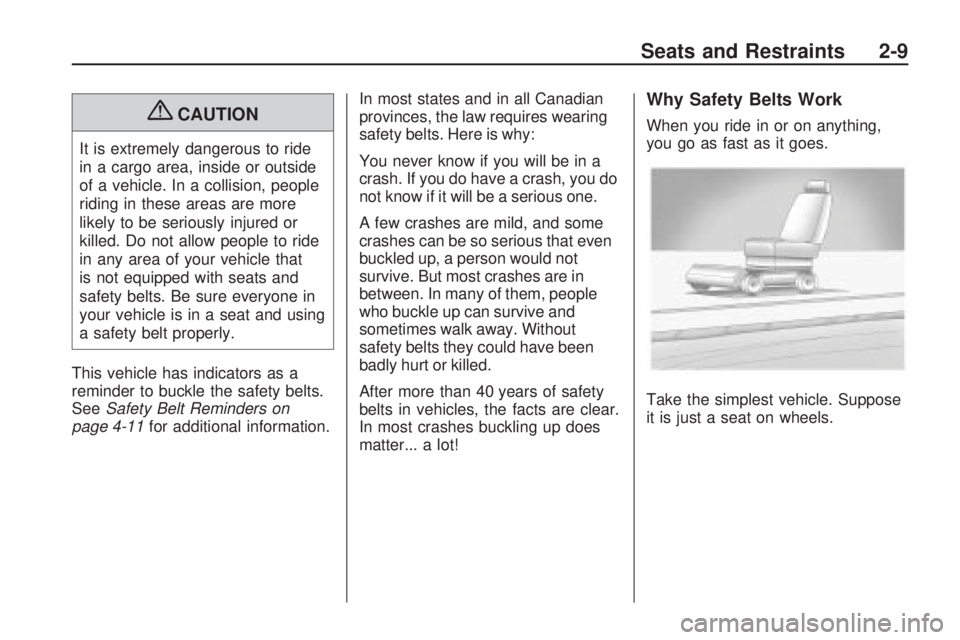
{CAUTION
It is extremely dangerous to ride
in a cargo area, inside or outside
of a vehicle. In a collision, people
riding in these areas are more
likely to be seriously injured or
killed. Do not allow people to ride
in any area of your vehicle that
is not equipped with seats and
safety belts. Be sure everyone in
your vehicle is in a seat and using
a safety belt properly.
This vehicle has indicators as a
reminder to buckle the safety belts.
See Safety Belt Reminders on
page 4-11 for additional information. In most states and in all Canadian
provinces, the law requires wearing
safety belts. Here is why:
You never know if you will be in a
crash. If you do have a crash, you do
not know if it will be a serious one.
A few crashes are mild, and some
crashes can be so serious that even
buckled up, a person would not
survive. But most crashes are in
between. In many of them, people
who buckle up can survive and
sometimes walk away. Without
safety belts they could have been
badly hurt or killed.
After more than 40 years of safety
belts in vehicles, the facts are clear.
In most crashes buckling up does
matter... a lot!
Why Safety Belts Work
When you ride in or on anything,
you go as fast as it goes.
Take the simplest vehicle. Suppose
it is just a seat on wheels.
Seats and Restraints 2-9
Page 30 of 318
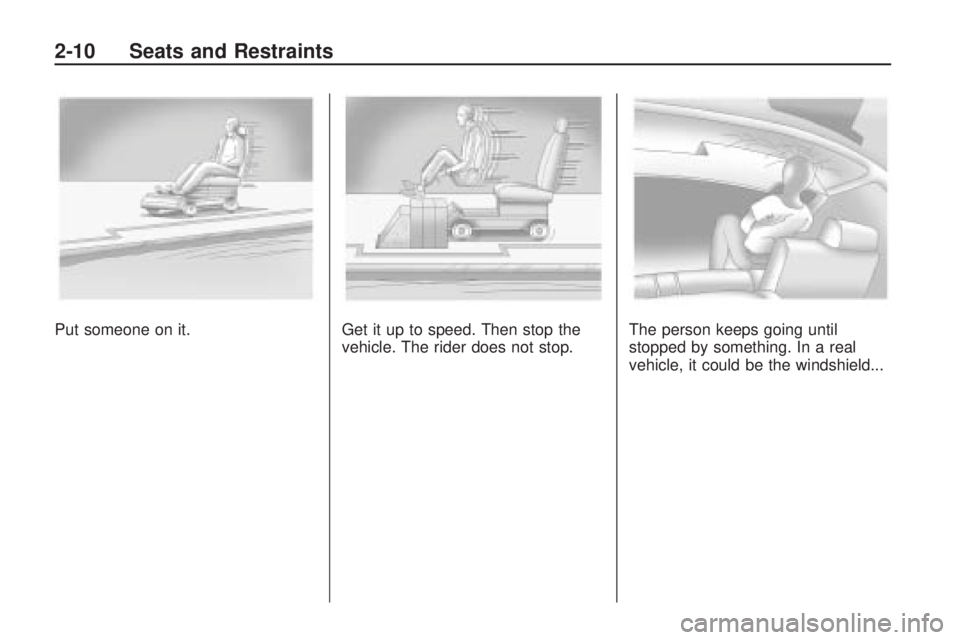
Put someone on it.Get it up to speed. Then stop the
vehicle. The rider does not stop. The person keeps going until
stopped by something. In a real
vehicle, it could be the windshield...
2-10 Seats and Restraints